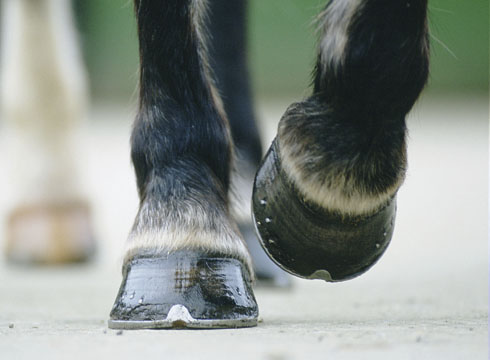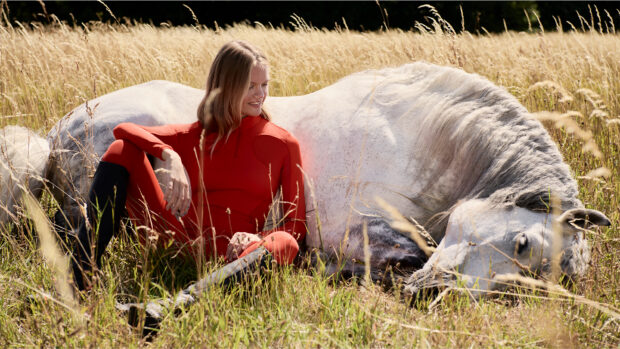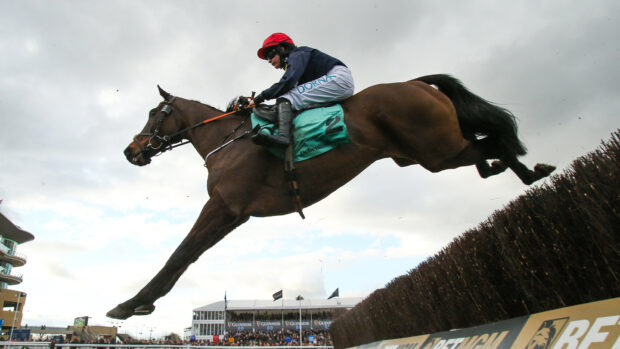They can’t tell us when they feel under the weather so it’s our job to make sure we’re constantly monitoring our horses to spot any underlying health issues. And there are a few common hoof problems for which horse owners can be on the alert at all times.
Farrier Ben Benson AWCF describes six common hoof problems to look out for next time you are cleaning horses’ hooves…
1. Bruising
Bruising is caused by direct trauma to the foot — for example, when a horse has kicked the stable door or wall. Bruises can also occur when one foot has struck into the other in the field or during work, or when a foot hits a pole.
How to spot: Look out for any unexplained lameness. Bruising will show more clearly on white hooves than black because of the pigmentation. Black feet do bruise as often and as much as white feet, but it is just more difficult to spot.
It may be that your horse is at the end of his shoeing cycle and his feet have grown out of balance. Shortening the time between farriery visits may help resolve the issue. A shorter shoeing cycle also means the feet are less out of balance, so there will be less uneven pressure on the hoof wall.
2. Thrush
Thrush is an infection which turns healthy frog into a necrotic, infected, black, slimy horn – the bacteria rots the frog as it’s the softest and most flexible horn on the horse’s foot. If the feet are not picked out thoroughly, bacteria will begin to impregnate the horn and start to break it down, creating a microclimate of warm, soft, wet horn.
How to spot: The most obvious sign of thrush is a black, foul-smelling discharge from the frog, which itself may have softer spots and appear irregular in shape. Horses with thrush often show no signs of lameness, despite the offensive smell and discharge.
The feet must be cleaned thoroughly to get rid of it completely. Cleaning the stable and disinfecting the floor and bedding is a must, and bare rubber mats should be avoided. If your horse is on straw, shavings on the floor under the bedding will help absorb the urine. Remove all droppings from the bed as often as possible and pick out the feet a few times a day. Scrub the frog with warm water and chlorhexidine (brand name Hibiscrub), then apply an antimicrobial spray. Dry for 10 minutes then apply hoof oil over the top – this helps seal the treatment and provide a waterproof barrier against anything infected the horse may stand in between treatments.
3. Sheared heels
Sheared heels are a structural breakdown between the heel bulbs that causes deep cracks in the frog’s central groove. They often result from bad cases of thrush, but can also cause such cases – sheared heels make it nearly impossible to pick the frog out properly. Sheared heels are primarily found in horses with conformational deformities, or in those whose feet have become unbalanced.
How to spot: They are incredibly painful, so lameness is expected. It can be much worse when the horse is walking or working on soft surfaces, as they tend to ball up in the feet and put direct pressure on the affected area.
Foot balance is key to managing sheared heels, and good stable management is key to treating the secondary problem of infection. If the horse is lame and uncomfortable, take your vet’s advice on pain management. Ensure your farrier or foot trimmer is aware of the issue and amends their work accordingly.
4. Rings on the hoof wall
Rings have many causes including; changes in environment where the growth of the horn slows down or speeds up, markings where the foot experiences a direct trauma leaving a mark in the horn, or concussion where one-off accidents or random footing placements cause the hoof wall to thicken.
How to spot: The rings on feet are quite often referred to as growth rings and can be seen on the hoof wall. They become visible only some time after the event which caused them, and are often superficial and will be dressed off when the feet are trimmed or shod.
If a horse is not trimmed or shod regularly then they can be more prominent. With oblique or diagonal ridges it is always worth looking to a farrier or trimmer to make sure that the foot balance is as optimal as possible.
5. Seedy Toe
Also known as white line disease, seedy toe makes the wall and white line of the hoof crumbling and “cheesy” in texture. Very wet or very dry conditions will exacerbate seedy toe, as will too long a gap between farrier visits or if the walls are allowed to grow over the shoe.
How to spot: The hoof wall will peel away or, sometimes, a cavity within the hoof wall will be visible.
Seedy toe is a combination of a bacterial and fungal infection; most remedies treat one or the other. Preventative measures include regular trimming to maintain foot balance and shorter trimming or shoeing cycles to reduce torque from uneven landing and loading on the shoes. Topical treatments are the mainstay of the remedies, consult your vet.
6. Cracks
Foot imbalance or overgrown feet are the main reason for cracks appearing on feet.
How to spot: Daily checks on your horse’s feet will allow you to see if a split or crack has appeared. Your vet can confirm if it is superficial or something more serious.
Make sure that feet are kept in balance and toes are not left too long. Large cracks or those that appear at the coronary band must be treated as serious. Horizontal cracks generally result from a trauma or an old infection that has blown out the coronary band. Cracks should be kept clean, and it is a good precaution to apply an antibacterial topical treatment to the split to reduce the chance of infection.
You might also be interested in:
Dr Stuart Thorne MRCVS, of Fellowes Farm Equine Clinic, gives useful tips to make poulticing easy

No foot, no horse – hoof supplements to help maintain healthy hooves

How to poultice a horse’s hoof: your essential guide

Put your best foot forward – and make it shine with one of these great hoof oils

Saddle up and go exploring in these great hoof boots

Subscribe to Horse & Hound magazine today – and enjoy unlimited website access all year round
Horse & Hound magazine, out every Thursday, is packed with all the latest news and reports, as well as interviews, specials, nostalgia, vet and training advice. Find how you can enjoy the magazine delivered to your door every week, plus options to upgrade your subscription to access our online service that brings you breaking news and reports as well as other benefits.




